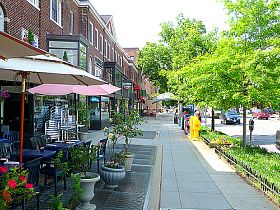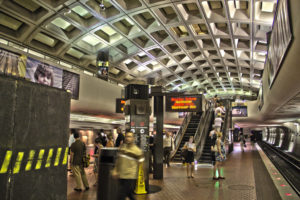Washington, D.C. has a lot to offer! With opportunities for government jobs, jobs with government contractors, and jobs servicing the government and its contractors, the Washington, D.C. area consistently boasts one of the lowest unemployment rates in the country.
Neighborhoods
Washington, D.C. includes many diverse neighborhoods, each with its own character. If you already have a job before moving to D.C., consider a neighborhood that is convenient to the same metro line as your place of employment. Some neighborhoods are more expensive than others, and your budget might not permit you to live along the same line as your job; but even if you have to change trains, living in a metro-accessible neighborhood allows you maximum freedom to explore the city without the hassle of driving and parking. Some popular neighborhoods and their associated metro lines include:
• Red Line: Cleveland Park, Woodley Park
• Yellow/Green Line: Columbia Heights
• Blue/Orange Line: Court House, Clarendon

The neighborhood of Adams Morgan is a popular late-night bar and nightclub destination for the college and young professional set. But many people also choose Adams Morgan when moving to DC for the quirky shops, trendy restaurants and hip, urban feel. The median age in this neighborhood is early 30s, approximately two-thirds of the residents are single, and two-thirds rent their homes or apartments.
Living in Ballston or any of the surrounding neighborhoods in northern Virginia (including Clarendon and Court House) provides access to D.C. without living in the district itself. Prospective residents who prefer newer homes or apartment buildings will find just that in Ballston, with the average age of homes being 10 years. By comparison, the average age of homes in D.C. itself is 65 years.
Cleveland Park is one of D.C.’s safest and most Metro-accessible neighborhoods. Many apartments and condominium buildings are located within a 10-minute walk to the Cleveland Park Metro station. For entertainment lovers moving to Cleveland Park, the Uptown Theatre features one very large screen and balcony and is the place to be when big blockbusters premiere. Cleveland Park also boasts a lineup of high-end restaurants within a few blocks of the Metro, so even non-residents visit often for an evening out.
Columbia Heights is considered by many to be one of the up-and-coming, trendy neighborhoods in Washington, D.C. It is less expensive than many other areas, with apartment rentals averaging less than $1,000 per month. This price range makes it a popular choice for students or recent college grads who are moving to D.C. The average age in this neighborhood is 31. Much of the revitalization of this historic D.C. neighborhood is due to the opening of the Columbia Heights metro stop in 1999, which has encouraged the growth of shopping, restaurants, nightlife and population.
Crystal City is a good D.C. neighborhood to call home if your job is in northern Virginia or located along the Blue or Yellow Metro lines. If airport access is a priority, it is one of the closest neighborhoods in the D.C. area to Ronald Reagan Washington National Airport.
If you want to be in the center of things when moving to D.C., and having a car is not important, the northwest neighborhood of Dupont Circle might be a good fit. Dupont Circle is located along the Red Line of the Metro, and features a variety restaurants, bars and shops. Living in this neighborhood is on the expensive side, but if you like older buildings, you might appreciate renting in one of the older row houses.
The Foggy Bottom neighborhood of Washington, D.C. is among the youngest, with a median age of 28. Largely due to the presence of George Washington University, many undergrads and graduate students who are moving to D.C. choose to live in this neighborhood for convenience. Only about 2% of the residences in this area include children; most growing families choose to move elsewhere for more space.
Attractions
The National Mall is a large, open park in downtown Washington between the Lincoln Memorial and the United States Capitol. Given its prominence, the mall is often the location of political protests, concerts, festivals, and presidential inaugurations. The Washington Monument and the Jefferson Pier are near the center of the mall, south of the White House. Also on the mall are the National World War II Memorial at the east end of the Lincoln Memorial Reflecting Pool, the Korean War Veterans Memorial, and the Vietnam Veterans Memorial.
Directly south of the mall, the Tidal Basin features rows of Japanese cherry blossom trees that originated as gifts from the nation of Japan. The Franklin Delano Roosevelt Memorial, George Mason Memorial, Jefferson Memorial, Martin Luther King, Jr. Memorial, and the District of Columbia War Memorial are around the Tidal Basin.

The Smithsonian Institution operates 19 museums and the National Zoo, all free to the public. The most visited museum is the National Museum of Natural History on the National Mall. Other Smithsonian Institution museums and galleries on the mall are: the National Air and Space Museum; the National Museum of African Art; the National Museum of American History; the National Museum of the American Indian; the Sackler and Freer galleries, which both focus on Asian art and culture; the Hirshhorn Museum and Sculpture Garden; the Arts and Industries Building; the S. Dillon Ripley Center; and the Smithsonian Institution Building (also known as “The Castle”), which serves as the institution’s headquarters.
There are many private art museums in the District of Columbia, which house major collections and exhibits open to the public such as the National Museum of Women in the Arts; the Corcoran Gallery of Art, the largest private museum in Washington; and The Phillips Collection in Dupont Circle, the first museum of modern art in the United States. Other private museums in Washington include the Newseum, the O Street Museum Foundation, the International Spy Museum, the National Geographic Society Museum, and the Marian Koshland Science Museum. The United States Holocaust Memorial Museum near the National Mall maintains exhibits, documentation, and artifacts related to the Holocaust.
The John F. Kennedy Center for the Performing Arts is home to the National Symphony Orchestra, the Washington National Opera, and the Washington Ballet. The Kennedy Center Honors are awarded each year to those in the performing arts who have contributed greatly to the cultural life of the United States. The historic Ford’s Theatre, site of the assassination of President Abraham Lincoln, continues to operate as a functioning performance space as well as museum.
Washington has a strong local theater tradition. Founded in 1950, Arena Stage achieved national attention and spurred growth in the city’s independent theater movement that now includes organizations such as the Shakespeare Theatre Company, Woolly Mammoth Theatre Company, and the Studio Theatre. Arena Stage opened its newly renovated home in the city’s emerging Southwest waterfront area in 2010. The GALA Hispanic Theatre, now housed in the historic Tivoli Theatre in Columbia Heights, was founded in 1976 and is a National Center for the Latino Performing Arts.
Cost of Living
The cost of living in Washington, D.C., is higher than in many other parts of the country. To get a better sense of what the cost of living in D.C. might be for you compared to your previous city of residence, check out the cost of living calculator at Payscale.com.
Transportation

Moving to D.C. means that you will be in a great city for public transportation. The Washington, D.C. metro system is how many people get to and from work. In fact, many D.C. residents can get by just fine without a car.
Biking is extremely popular in D.C., although riding on the main roads during rush hour is not for the faint-hearted. You can get the best of both worlds (on weekends, anyway) by taking your bike on the metro. Also, metro stations in D.C. have bike racks. D.C. recently introduced Capital Bikeshare, which allows users to rent bikes and return them at different points throughout the city.
If you do have a car, you will become intimately familiar with the Washington, D.C. Beltway. Also known as interstate 495, this multi-lane monster highway goes through parts of Maryland and Virginia and forms a circle around Washington, D.C. Traffic routinely slows to a crawl during the morning and evening rush hours, and even a minor accident or bad weather (including rain) makes things worse.
